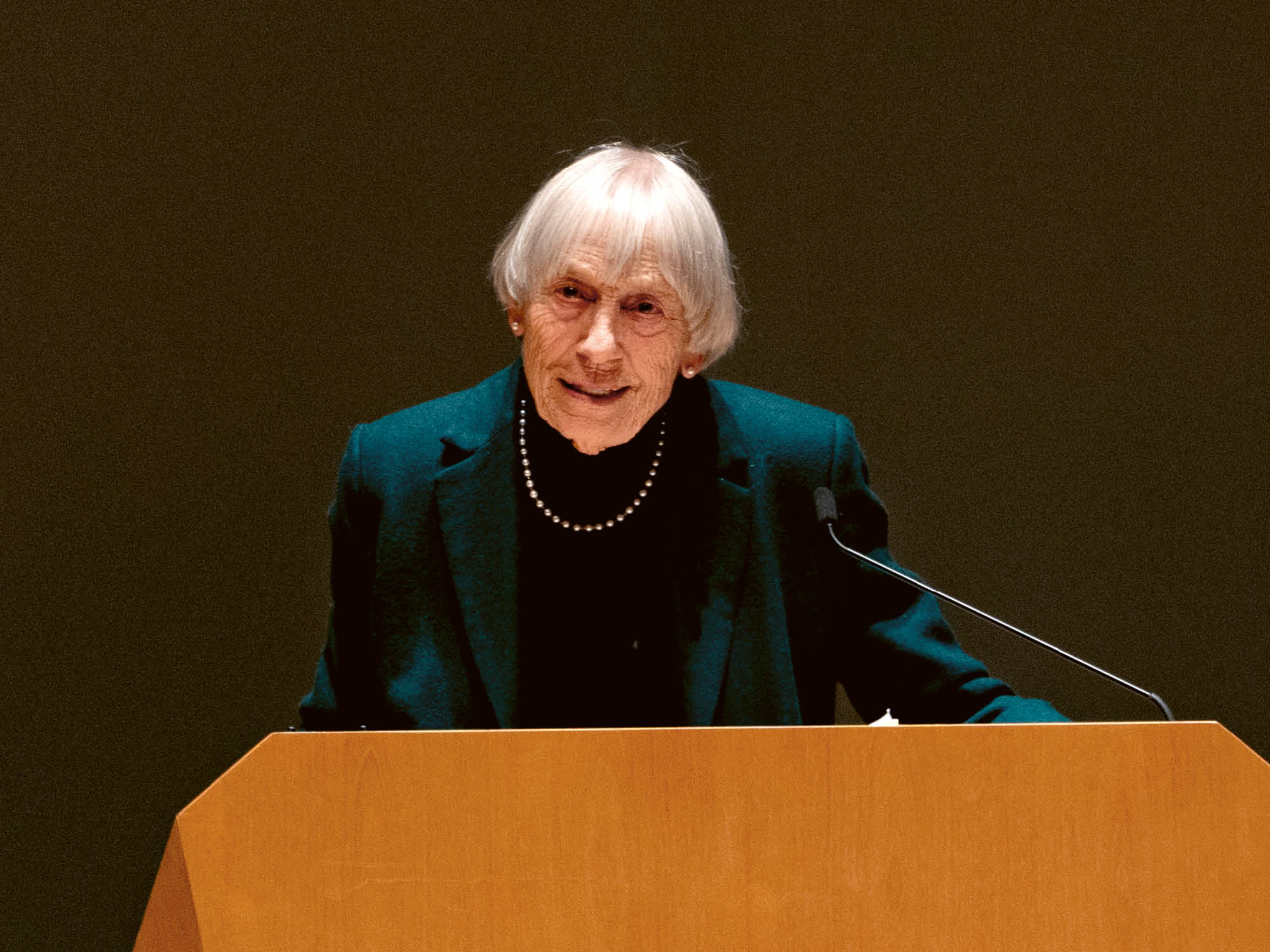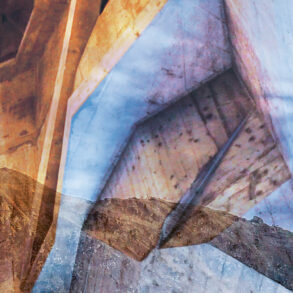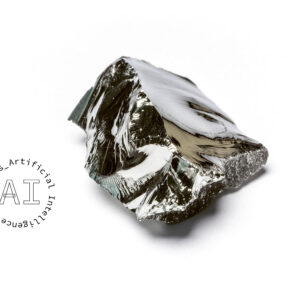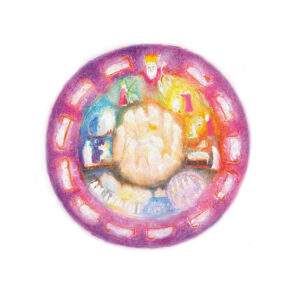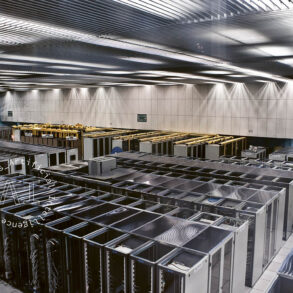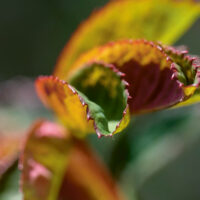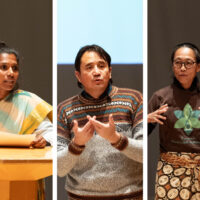There’s a grand mystery surrounding humankind like a shroud. That may sound dramatic, but it is a real mystery. Despite all the profound achievements in natural and spiritual science, no one can say what life is.
I meet a lot of natural scientists and researchers, and I always ask them: What is life? Where does it come from? Where does it go? No one can answer. We can describe how life flourishes, how it fades away; but not what it truly is. Did someone create it? To be a bit provocative, I’d say simply: it is the mysterious proof of God. I’d like to shed some light upon this mystery in its relation to the Earth and us human beings.
Three Lives
I’m struck by the fact that there’s only one term for life in German: Leben, life. Ancient Greek, the language of the New Testament, for example, has three concepts for life. “Bios” refers to the life of plants, which don’t have consciousness. “Zoae” (from which we get the word “zoo”), I’d translate as “soul life”—from an anthroposophical perspective, it’s the etheric life that plants have together with the astral life that animals and humans possess. Zoae is used in two important passages in the Gospel, in the prologue to the Gospel of John: “In it, was the life.” It doesn’t say bios, it says zoae, the life of soul, conscious life. “And the life was the light of the human being.” And there’s a third concept applied to the immortal ‘I’: “aion.” This is where the word “aeon” comes from: eternal life, immortal life, imperishable life.
I think it’s important for biologists to know that bios concerns a specific layer of life, not the whole of life. I say that out of a sense of wonder, not in any limiting way. German sociologist Hartmut Rosa coined the concept “unavailable” [Unverfügbaren, which also means “sacrosanct; inaccessible”] to refer to everything that cannot be bought; something like happiness, for example. Nobody can foresee whether happiness will come. No one knows whether a meeting with someone they’ve been looking forward to seeing for years will really turn out the way they want it to. There’s always something unavailable. The mysteries surrounding these areas of life surround our Earth like a kind of aura.
Signs of Life
Referring to the seven life processes [the theme of the conference], I’d like to describe three areas that have become especially meaningful to me in the course of my life because I have spent time observing them. What is a sign of all life? The breath! When someone is near death, near the end of their life, we wait at their bedside to know when they will take their last breath. We participate in this moment, in this process of waiting with our whole being: body, soul, and spirit. We become their breath, their breathing, and wait, trembling in our heart. The breath slows, becomes hesitant, seems to stop—but then comes again. This is a moment where we discover how precious our breath is. When ultimately the last breath is drawn in and given out, there comes a stillness not present or producible anywhere else in the world. All becomes so filled with quiet that we suddenly hear our own breath. And in this moment, when a life has ended, we experience that there’s now an open space where once was life. When a person is born and takes their first breath, we experience the opposite of the end of life: the whole of life is breathed in by a tiny being, and a cry declares: I have breathed! We experience the all-encompassing, world-embracing vitality and how the fact that we breathe affects our whole person. That is the message of life: the breath. So, it’s not surprising that in the story of creation, the breath is called spirit, “pneuma” in Greek. The breath of God hovered over the primordial waters before life was created. This is a cosmic breath. And just as man breathes, so does the Earth—on a grand scale, in every moment.
A second sign of life is movement. The solidification of life is a powerful force, very different from the solidification occurring in technology, for example, where there’s neither breath nor movement. We can see the solidification of life, for instance, when a body of water turns to ice in wintertime. Near my home in Berlin, there are large lakes reaching right into the center of the city. I was wandering about there during Advent, when the reflective, calm surface of the water suddenly took on a kind of skin. Solidifying forces brought the vitality of the water to stillness, to solidity. But we can see, when we look with the knowledge of our heart, that this solidification carries within it its own counter-pole. This solidification is not an end (as we clearly see with water); it flows into liquidity again.
So, the second sign of life is movement: in humans, the heartbeat. When a person is admitted to a hospital, we check the pulse first: Are they breathing? Is their heart beating? The pulse is also a sign of life. We learn a lot about life when we listen to our hearts and breathing. We don’t know who made this life, but we may have a premonition.
There’s a third sign, most striking to me in the life processes of Earth: the beauty of the Earth. There are incredible sights—and, in this day and age, we feel a twinge in our hearts because we ask ourselves: How long will this last? How long will there still be a row of trees like this one? How long will there be sunsets of such exquisite beauty? The twilight, the quiet activities filled with beauty, come to our sense perceptions in the most manifold sensations. The Earth is endlessly beautiful! Wherever you go, everywhere upon the whole of the Earth, it is beautiful—beautiful to the human being. Who conceived this beauty? Who is the producer and director of such beauty? These are three aspects of life that both sustain and connect to the etheric, soul, and spiritual realms of humanity.
Gifts of Earth
What is it that we owe most of all to the Earth? Its firmness, its solid ground upon which we can stand, so that we can hold ourselves upright upon it and we can develop an ‘I’. The ‘I’ is connected to our upright posture. The human being is the only being on the Earth who stands permanently upright, not just for a few moments.
A small child only says ‘I’ to itself once it can sit up. Until that moment, they call themselves by their first name. Naming ourselves with ‘I’ and self-awareness are linked to standing up straight. Uprightness is also linked to sincerity, to the ability to tell the truth. This we owe to the Earth; organically, we owe it to our spine, which enables us to stand upright.
The next thing we owe to the earth is food, of course. We receive this incredible gift by literally taking it into ourselves. Food gives itself to us completely, and by taking in the food of the Earth, we transform a piece of the Earth. We transform the Earth and give something back in return for what it gives us as the gift of food. Rudolf Steiner gave us a grace to say before meals. Not only does it express gratitude from the soul, but it also acknowledges the Earth, what it is to us through its gift of food:
The seeds are quickening in the dark night of the Earth.
The leaves are sprouting through the might of the air.
The fruits are ripening by the power of the sun.
Thus quickens the soul in the shrine of the heart.
Thus sprouts spirit-power in the light of the world.
Thus ripens man’s strength in the Glory of God.
Es keimen die Pflanzen in der Erdennacht / Es sprossen die Kräuter durch der Luft Gewalt / Es reifen die Früchte durch der Sonne Macht / So keimet die Seele in des Herzens Schrein / So sprosset des Geistes Macht im Licht der Welt / So reifet des Menschen Kraft in Gottes Schein.
In this prayer of grace, the relationship, the communal life between Earth and humanity is made wholly transparent, because we’re not making a request but simply stating facts.
By coming fully into connection with the Earth, we receive life; we take it into ourselves and give something back to it that it needs. We know from anthroposophy that humans and the Earth have gone through previous embodiments. With every incarnation upon the Earth, we humans are given a new member of our true being.
And the Earth is the planet upon which we develop our ‘I’. The ‘I’ is the youngest member of our being. We cannot do this without the help of the Earth. The Earth makes its home within us through our senses. The human ‘I’ organization works through our senses. I grew up on a large estate in central Germany, where I was able to be entirely devoted to the life of the senses. That’s how I was able to be completely sheltered from the war. There, I conquered the world with my senses. I remember the stables, their smells and sounds. And the remarkable thing is—it doesn’t go away, even in a ripe old age. The perceptions I had there have strengthened my vitality through my many years and still do. It is the Earth: the primal health under our feet giving support and uprightness, strengthening our sensory organization, holding and protecting us.
Then, there’s the course of the year: the Earth’s breathing process. The whole Earth takes a great breath through the course of one year. It goes without saying that wherever we live on Earth, we participate in this breathing process. In our latitudes here, where we live, we’re not so well incarnated during the summertime as we are in winter. We dream in the summer. That’s part of what we do.
The ‘I’-Bearer
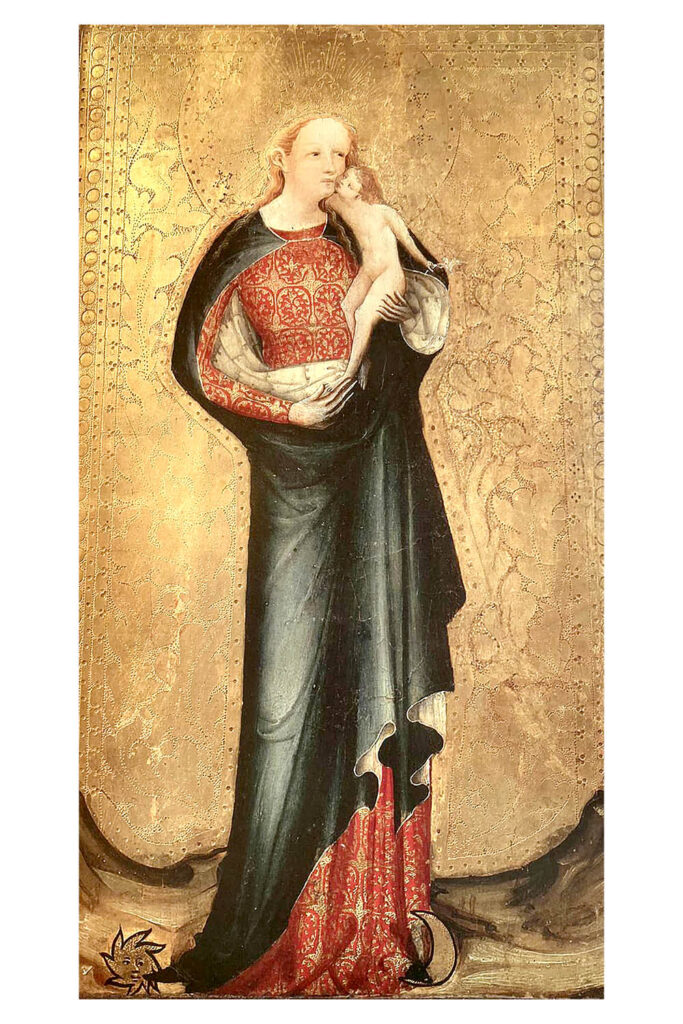
Here’s a painting from the Berlin Gemäldegalerie [Painting Gallery]. It’s from the sixteenth century; the painter is unknown. It’s not a picture of the Madonna but rather the Woman Clothed with the Sun from the Apocalypse. She brings forth the ‘I’. She is the ‘I’-Bearer. Her story is filled with the wonder of mystery. She’s known throughout various religions: as Isis, for instance, she brings forth the boy Horus; later, she appears as the mother of Jesus. And yet, she goes beyond these images because she is a figure from the future, who gives birth to this child for humanity and who helps us give birth to our ‘I’ upon the Earth. What is special about this image is that the child is instantly whisked away from her and delivered to God’s throne, because the dragon is after this child, just as the dragon is after the human ‘I’. The child is neither male nor female; just as the ‘I’ is neither. The ‘I’ is spirit, that which we will conceive, with which the future begins, the apocalypse of man: all of this is depicted in this image.
The female figure has the moon at her feet and is surrounded by the sun. From this, we can recognize who she is. She has the sun around her as an aura and announces the birth of the ‘I’, which is slowly preparing to become immortal and the Earth along with it. We would not be ‘I’-beings if we had no aims in life. Our aims belong to the ‘I’: I know where I want to go; I know that I’m on my way. In the last book of the Apocalypse, two aims are given in grand imaginations. Rudolf Steiner called them “freedom” and “love.” They will bring the life of man and the life of the Earth, and also their souls, to the goal, and thus they will continue after life on Earth. Freedom is illustrated by the fact that, in Heavenly Jerusalem, there is no longer a temple. Man no longer needs a temple because God is within him. Love is depicted in the marriage of the bride and the Lamb. We have only just begun to unite love and freedom—to love something and, in complete freedom, to let it be free. We still want to grasp what we love with our senses. The aim of our love will have a different orientation when completely permeated by freedom. Freedom will not be about our own freedom but will be permeated by the freedom of others, namely, with love. It is always good that we keep this ideal of the Apocalypse before us, that we recognize where we are heading, what we are still missing, and where we are turning our gaze to behold what will be. Once we do achieve this, when freedom and love become reality, together within us, it won’t matter what we call God. There will be one God of humanity, one religion of humanity.
According to the Bible and the Old Testament, humanity originated from a garden and flows into a crystal, heavenly Jerusalem. The city is a throne, and on this throne sits the Lamb, and beneath this throne flows a river. And this river that rises forms a new garden, and there are trees that bear fruit twelve times every year. These fruits are remedies, remedies for our words. We will speak differently; we will always understand one another. That’s what the leaves on these trees are for. Humanity will be in a garden again.
The Development of Love
In Rudolf Steiner’s lecture cycle Universe, Earth, Human Being (CW 105), he speaks of gods, humanity, and the Earth. Only through the development of the ‘I’ does love exist. Only the ‘I’ is capable of love in a higher sense. Love springs from the human ‘I’. The gods instill this love in human beings who live upon the Earth, who are involved in the development of their ‘I’. We receive something from heaven when we’re on Earth, and we form our ‘I’ through the pain and toil of our destiny. This is the love that comes from the gods. Gratitude can arise in us when we realize this. A great, mighty festival of the harvest. And this gratitude rises up, invisibly, to the gods. That is the archetype of the cultus. And through this rising up—immensely difficult for us to believe and understand—the gods, themselves, then learn to love. They learn love from human beings.
It’s like a gift. Love is kindled in human beings on Earth by the gods so that human beings can learn to experience love. And the gods learn to love, love as manifest reality, only through human beings. When human beings do not live with love, the gods must go without. The more love humans have upon the Earth, the more nourishment the gods have in heaven. We don’t just have two goals: freedom and love. These are actually gifts, as we see. The third apocalyptic task is the twelve precious stones. The twelve precious stones are the spiritualized Earth, which does not come into being on its own, but through the work of human beings, the work upon the Earth, the work upon ourselves, on our karma. We can only achieve freedom and love through the gifts we receive. But the work upon the Earth, this is our task.
These are edited excerpts from the presentation held at the Agriculture Conference in Dornach, 2025. The entire presentation will be available on Goetheanum TV.
More Agriculture Section at the Goetheanum
Translation Joshua Kelberman
Title Image Mechthild Oltmann, photo: Xue Li

